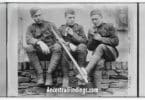When the Civil War ended in 1865, the United States was scarred but standing. The fields were silent, the guns were still, and the soldiers — Union and Confederate alike — began the long journey home. But what if “home” no longer existed? For thousands of veterans, returning wasn’t an option. They had to start over somewhere else.
Many of them packed up and headed west.
That decision shaped the lives of entire generations.
Why Go West?
For some, the west meant opportunity. For others, it was simply distance — distance from battlefields, from destruction, from memories that wouldn’t fade. Railroads were being built, towns were popping up overnight, and land was suddenly available to buy or claim. With the Homestead Act still in place, a veteran could stake out a new life on 160 acres of open land — sometimes more if he had military service.
The western states and territories became magnets for men trying to rebuild, reset, or escape.
Union and Confederate Paths
Union veterans, especially those from the Midwest and Northeast, often moved into new territories like Nebraska, Kansas, the Dakotas, and parts of Colorado and Wyoming. Their military background gave them an edge in government hiring, law enforcement, postal work, and railroad jobs.
Confederate veterans had a tougher path. Many returned to ruined farms and faced ongoing political restrictions. Some moved into Texas, which had seen fewer large-scale battles. Others crossed into Indian Territory or further west, hoping for a clean slate.
In both cases, these migrations were not just physical. They were emotional and cultural. These men were carrying war trauma into unfamiliar towns and trying to build peace from brokenness.
Finding the Trails They Left Behind
You can trace your ancestor’s post-war movement by looking for patterns in the records:
- State census records in places like Kansas, Nebraska, and Iowa
- Land patent records through the Bureau of Land Management
- Homestead files which may include family details and personal affidavits
- Civil War pension applications, which often list current residences and prior moves
- County histories, which sometimes mention veteran settlers by name
- Newspapers, which may contain veterans’ obituaries, reunion notices, or land sale announcements
If your ancestor seems to “vanish” from his home state after the war, widen your search. He may have gone west — and started a whole new chapter you didn’t know about.
Veterans as Founders and Builders
These men didn’t just settle land. They built towns. Many served on city councils, ran general stores, founded churches, or became schoolteachers. Civil War veterans were often regarded as men of honor and grit, giving them status in young communities desperate for leadership.
Local records in western states may show your ancestor’s involvement in:
- Town founding committees
- School board appointments
- Local militias or fire brigades
- Churches and fraternal organizations like the Masons or Odd Fellows
Don’t overlook GAR (Grand Army of the Republic) records either — these were Union veteran organizations that kept rosters, meeting minutes, and memorial lists. If your ancestor was a GAR member in a western town, you might find mentions in local histories or even surviving lodge records.
Confederate Veterans Who Left the Country
Some Southern veterans didn’t stop in Texas — they kept going. Many left the country entirely. This included:
- “Confederados” who settled in Brazil, where slavery was still legal until 1888
- Small Confederate settlements in Mexico, where Emperor Maximilian offered land and protection
- Groups that migrated to British Honduras (now Belize)
If your ancestor “disappeared” from American records and had strong Confederate ties, you might find them mentioned in Brazilian or Central American colonial settlement papers, though these records can be harder to access.
What the Move Meant for the Next Generation
These post-war moves reshaped family trees. A son born in Georgia might end up a cattleman in Oklahoma. A daughter from Pennsylvania might marry into a Nebraska farming family. Entire branches shifted across the map in a single generation — all because a Civil War veteran decided he needed a new start.
As family historians, these turning points are key. They help explain sudden name changes in the records, gaps in census trails, and mysterious moves that puzzled earlier researchers.
Tips for Tracking Civil War Veterans Who Moved West
- Use the 1890 Veterans Schedule (for Union soldiers) — it’s a rare surviving slice of the destroyed 1890 census and lists many western veterans.
- Check military pension cards for changes in residence — they often note counties and states across different years.
- Search land patents through the Bureau of Land Management’s GLO Records database.
- Explore county history books — many are digitized and searchable by surname.
- Search for GAR posts by location — some even published rosters or member lists.
A Second Life on the Frontier
The war changed them, and the West gave them space to figure out who they were after it all ended. Some found peace. Others found purpose. A few simply disappeared into the wide open land.
But all of them left traces — in deeds, in pension files, in local memory.
If your family tree has a blank space after the Civil War, take a look westward. That’s where many second lives began — and where your next great family discovery may be waiting.






